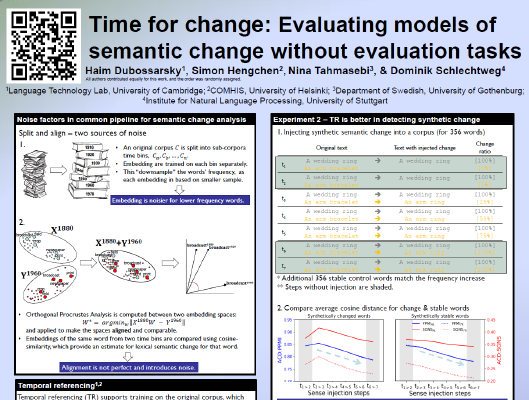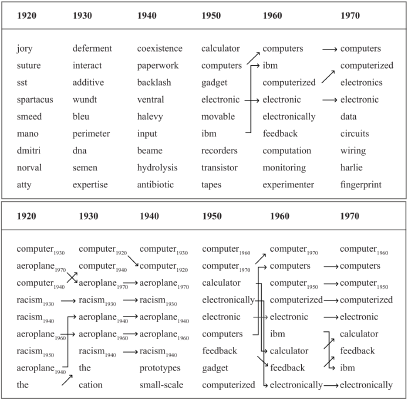Filter by type:
(Chat)GPT v BERT: Dawn of Justice for Semantic Change Detection
In the universe of Natural Language Processing, Transformer-based language models like BERT and (Chat)GPT have emerged as lexical …
EMNLP 2023
We present Superlim, a multi-task NLP benchmark and analysis platform for evaluating Swedish language models, a counterpart to the …
ChiWUG: A Graph-based Evaluation Dataset for Chinese Lexical Semantic Change Detection
we present the compilation of the first graph-based evaluation dataset for lexical semantic change in the context of the Chinese …
Incremental Semantic Shift Detection
In this paper, we introduce a novel approach to tracing the evolution of word meaning over time.
Routledge Handbook of Historical Linguistics, 2nd Edition
In this chapter we provide an overview of computational modeling for semantic change using large and semi-large textual corpora
Nodalida 2023
In this work we investigate the hypothesis that enriching contextualized models using fine-tuning tasks can improve their capacity to …
LSCDiscovery: A shared task on semantic change discovery and detection in Spanish
We present the first shared task on semantic change discovery and detection in Spanish. We create the first dataset of Spanish words …
DiaWUG: A Dataset for Diatopic Lexical Semantic Variation in Spanish
We provide a novel dataset – DiaWUG – with judgements on diatopic lexical semantic variation for six Spanish variants in Europe and …
DWUG: A large Resource of Diachronic Word Usage Graphs in Four Languages
In this paper, we describe the creation of the largest resource of graded contextualized, diachronic word meaning annotation in four …
Visualization systems and novel applications
This chapter is to survey visualization and user interface solutions for understanding lexical semantic change and potential …
Survey of computational approaches to lexical semantic change detection
This article provides a comprehensive survey of recent computational techniques to tackle both diachronic conceptual change (semantic …
Computational approaches to semantic change
This volume offers a survey of this exciting new direction in the study of semantic change, a discussion of the many remaining …
Challenges for computational lexical semantic change
In this chapter, we aim to describe the most important of these challenges and outline future directions for the field of lexical …
SemEval-2020 Task 1: Unsupervised Lexical Semantic Change Detection
Lexical Semantic Change detection, i.e., the task of identifying words that change meaning over time, is a very active research area, …
Post-Evaluation Data for SemEval-2020 Task 1: Unsupervised Lexical Semantic Change Detection
This data collection contains the post-evaluation data for SemEval-2020 Task 1
Time for change: Evaluating models of semantic change without evaluation tasks
State-of-the-art models of lexical semantic change detection suffer from noise stemming from vector space alignment. We have …
Time-Out: Temporal Referencing for Robust Modeling of Lexical Semantic Change
State-of-the-art models of lexical semantic change detection suffer from noise stemming from vector space alignment. We have …
Survey of Computational Approaches to Lexical Semantic Change
This article is a survey of recent computational techniques to tackle lexical semantic change, in particular we focus on diachronic …
Every Word has its History: Interactive Exploration and Visualization of Word Sense Evolution
Human language constantly evolves due to the changing world and the need for easier forms of expression and communication. In this …
Finding Individual Word Sense Changes and their Delay in Appearance
We present a method for detecting word sense changes by utilizing automatically induced word senses. Our method works on the level of …
The Role of Language Evolution in Digital Archives
With advancements in technology and culture, our language changes. We invent new words, add or change meanings of existing words and …
NEER: An Unsupervised Method for Named Entity Evolution Recognition
High impact events, political changes and new technologies are reflected in our language and lead to constant evolution of terms, …
Terminology Evolution in Web Archiving: Open Issues
The correspondence between the terminology used for querying and the one used in content objects to be retrieved, is a crucial …




